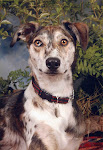
I was asked by Margaret if I would help with the fundraising for his operation and of course, as you know by now he came home to live with us. At the time I knew nothing about HD, the suffering and pain that it can cause but I knew that we needed to find probably £6,000 to fund his operation.
Well, Barty grew and grew like topsy after he was fed properly and by the time he was 18 months old – he was running like the wind, chasing rabbits and walking miles with us. No sign of any problems.
Then when he was coming up two years old he started having difficulty getting up, he was chewing at his back and crying out in pain when he wasn’t even doing anything. He was referred to one of the country’s leading orthopaedic specialists who had pioneered THR’s in the UK. When he saw Barty he didn’t think it was his hips that were causing his problem and he was admitted to have xrays and scans of his spine and hip area.
When we saw the results of these tests I was shocked. He didn’t have any hip sockets at all and his leg bones were two inches above his pelvis but what was causing his problem was a serious malformation of his lower spine. His spinal column was too narrow and too short, it was pinching on the spinal cord and this was what was causing his pain.
The next day Barty went in for laminectomy – this is where they remove part of the vertebrae in his spine – open up the column to make it bigger – and then patch him back together with a bit of fat from else where and some cement. He spent the next 8 weeks in a cage – which for a young dog who was designed and born to run free was a hard thing to do.
But …….. after the operation he was 95% better – no more pain, yelping or difficulty getting up. Fantastic.

No comments:
Post a Comment